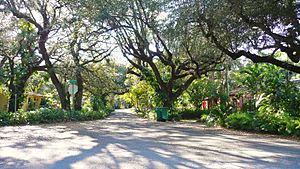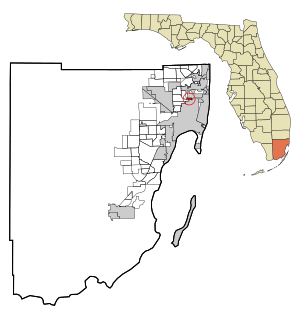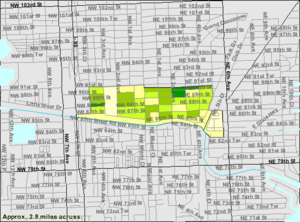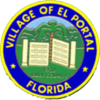El Portal, Florida facts for kids
Quick facts for kids
El Portal, Florida
|
||
|---|---|---|
| Village of El Portal | ||

Typical street in El Portal
|
||
|
||

Location in Miami-Dade County and the state of Florida
|
||

U.S. Census Bureau map showing village boundaries
|
||
| Country | ||
| State | ||
| County | ||
| Incorporated | December 6, 1937 | |
| Government | ||
| • Type | Council–Manager | |
| Area | ||
| • Total | 0.42 sq mi (1.09 km2) | |
| • Land | 0.42 sq mi (1.08 km2) | |
| • Water | 0.01 sq mi (0.01 km2) | |
| Elevation | 7 ft (2 m) | |
| Population
(2020)
|
||
| • Total | 1,986 | |
| • Density | 4,774.04/sq mi (1,844.35/km2) | |
| Time zone | UTC-5 (EST) | |
| • Summer (DST) | UTC-4 (EDT) | |
| ZIP Codes |
33138, 33150
|
|
| Area code(s) | 305, 786, 645 | |
| FIPS code | 12-20650 | |
| GNIS feature ID | 0282132 | |
El Portal is a small village located in Miami-Dade County, Florida, in the United States. Its name comes from the Spanish words for "the gate." This is because two large wooden gates once stood at the entrance to the village.
El Portal was first made part of the city of Miami in 1925. But during the Great Depression, Miami gave up control. So, El Portal became its own village in 1937. It is now part of the larger Miami metropolitan area in South Florida. In 2020, about 1,986 people lived in El Portal.
Contents
History of El Portal
The Village of El Portal is a small, diverse community. It is located between the cities of Miami Shores and Miami. The village officially became its own town on December 6, 1937.
Long ago, this area was the main place for the Tequesta tribe. A Spanish explorer named Pedro Menéndez de Avilés visited them in the 1560s. Over time, three smaller areas called Sherwood Forest, El Jardin (which means "The Garden" in Spanish), and El Portal joined together to form the village we know today.
The name "El Portal" means "the gate" in Spanish. This refers to two big wooden gates that were on Northeast Second Avenue. These gates were taken down in the 1940s.
For over 50 years, the state of Florida has called El Portal a bird sanctuary. This means that birds and trees in the village are protected and cannot be harmed. There is also a nature trail that winds through the village.
El Portal also has a special link to ancient Native American life. There is a place called the Little River Mound. It looks like a small grassy hill, but it is actually an old burial ground. This mound is in the Sherwood Forest area. It was the first archaeological site in Miami-Dade County to be officially recognized and protected.
Geography of El Portal
El Portal is located about 6 miles (9.7 km) north of downtown Miami. It is at the coordinates 25°51′19″N 80°11′39″W.
The village has different neighbors. To the south and east, it borders the city of Miami. To the north, it is next to the village of Miami Shores. To the southwest, it borders an area called West Little River.
According to the United States Census Bureau, El Portal covers a total area of about 0.4 square miles (1.0 km²). A very small part of this area, about 0.005 square miles (0.013 km²), is water.
Climate in El Portal
El Portal has a tropical climate. This is similar to the weather found in many parts of the Caribbean. It is one of the few places in the United States that has this type of climate.
More specifically, El Portal usually has a tropical savanna climate. This means it has warm temperatures all year round. It also has a wet season and a dry season.
Population of El Portal
The population of El Portal has changed over the years. Here is how many people have lived in the village during different census years:
| Historical population | |||
|---|---|---|---|
| Census | Pop. | %± | |
| 1940 | 365 | — | |
| 1950 | 1,371 | 275.6% | |
| 1960 | 2,079 | 51.6% | |
| 1970 | 2,068 | −0.5% | |
| 1980 | 2,055 | −0.6% | |
| 1990 | 2,457 | 19.6% | |
| 2000 | 2,505 | 2.0% | |
| 2010 | 2,325 | −7.2% | |
| 2020 | 1,986 | −14.6% | |
| U.S. Decennial Census | |||
The table below shows the different racial and ethnic groups living in El Portal. Remember that Hispanic/Latino is an ethnic group, and people of any race can be Hispanic/Latino.
| Race / Ethnicity (NH = Non-Hispanic) | Pop 2010 | Pop 2020 | % 2010 | % 2020 |
|---|---|---|---|---|
| White (NH) | 441 | 480 | 18.97% | 24.17% |
| Black or African American (NH) | 1,106 | 684 | 47.57% | 34.44% |
| Native American or Alaska Native (NH) | 3 | 4 | 0.13% | 0.20% |
| Asian (NH) | 28 | 43 | 1.20% | 2.17% |
| Pacific Islander or Native Hawaiian (NH) | 1 | 3 | 0.04% | 0.15% |
| Some other race (NH) | 23 | 23 | 0.99% | 1.16% |
| Mixed race or Multiracial (NH) | 58 | 73 | 2.49% | 3.68% |
| Hispanic or Latino (any race) | 665 | 676 | 28.60% | 34.04% |
| Total | 2,325 | 1,986 | 100.00% | 100.00% |
2020 Census Information
In 2020, there were 1,986 people living in El Portal. There were 770 households and 451 families in the village.
2010 Census Information
In 2010, the village had 2,325 people. There were 836 households and 581 families living there at that time.
Religion in El Portal
The most common religion practiced in El Portal is Catholicism, with about 24% of the population. About 4% of the population practices Judaism.
There is also a Rader Methodist church in El Portal. It is considered the oldest church in Miami and has been there since the 1920s.
Gallery
See also
 In Spanish: El Portal (Florida) para niños
In Spanish: El Portal (Florida) para niños



